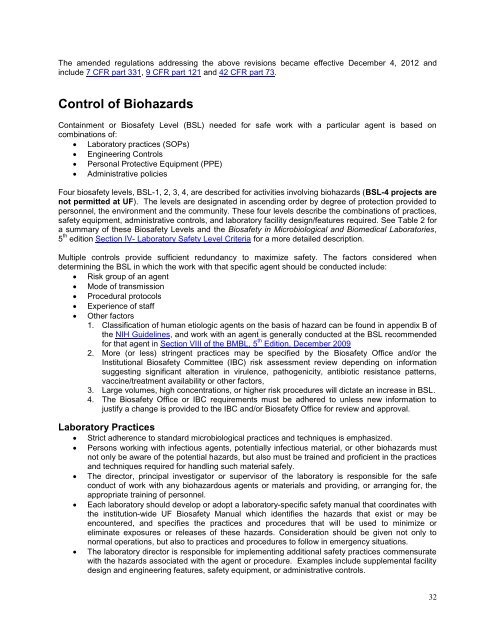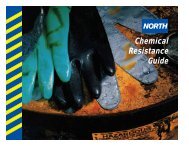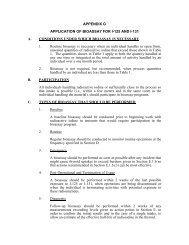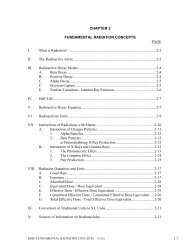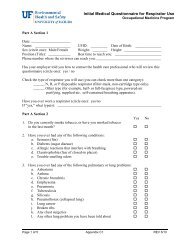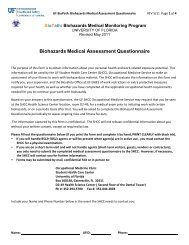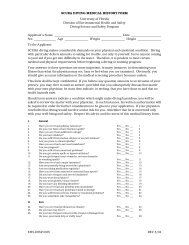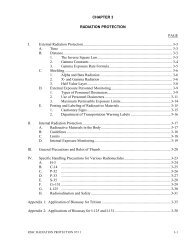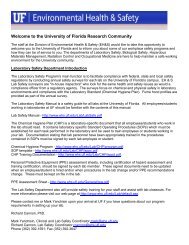Biological Safety Manual - University of Florida
Biological Safety Manual - University of Florida
Biological Safety Manual - University of Florida
You also want an ePaper? Increase the reach of your titles
YUMPU automatically turns print PDFs into web optimized ePapers that Google loves.
The amended regulations addressing the above revisions became effective December 4, 2012 andinclude 7 CFR part 331, 9 CFR part 121 and 42 CFR part 73.Control <strong>of</strong> BiohazardsContainment or Biosafety Level (BSL) needed for safe work with a particular agent is based oncombinations <strong>of</strong>: Laboratory practices (SOPs) Engineering Controls Personal Protective Equipment (PPE) Administrative policiesFour biosafety levels, BSL-1, 2, 3, 4, are described for activities involving biohazards (BSL-4 projects arenot permitted at UF). The levels are designated in ascending order by degree <strong>of</strong> protection provided topersonnel, the environment and the community. These four levels describe the combinations <strong>of</strong> practices,safety equipment, administrative controls, and laboratory facility design/features required. See Table 2 fora summary <strong>of</strong> these Biosafety Levels and the Biosafety in Microbiological and Biomedical Laboratories,5 th edition Section IV- Laboratory <strong>Safety</strong> Level Criteria for a more detailed description.Multiple controls provide sufficient redundancy to maximize safety. The factors considered whendetermining the BSL in which the work with that specific agent should be conducted include: Risk group <strong>of</strong> an agent Mode <strong>of</strong> transmission Procedural protocols Experience <strong>of</strong> staff Other factors1. Classification <strong>of</strong> human etiologic agents on the basis <strong>of</strong> hazard can be found in appendix B <strong>of</strong>the NIH Guidelines, and work with an agent is generally conducted at the BSL recommendedfor that agent in Section VIII <strong>of</strong> the BMBL, 5 th Edition, December 20092. More (or less) stringent practices may be specified by the Biosafety Office and/or theInstitutional Biosafety Committee (IBC) risk assessment review depending on informationsuggesting significant alteration in virulence, pathogenicity, antibiotic resistance patterns,vaccine/treatment availability or other factors,3. Large volumes, high concentrations, or higher risk procedures will dictate an increase in BSL.4. The Biosafety Office or IBC requirements must be adhered to unless new information tojustify a change is provided to the IBC and/or Biosafety Office for review and approval.Laboratory PracticesStrict adherence to standard microbiological practices and techniques is emphasized.Persons working with infectious agents, potentially infectious material, or other biohazards mustnot only be aware <strong>of</strong> the potential hazards, but also must be trained and pr<strong>of</strong>icient in the practicesand techniques required for handling such material safely.The director, principal investigator or supervisor <strong>of</strong> the laboratory is responsible for the safeconduct <strong>of</strong> work with any biohazardous agents or materials and providing, or arranging for, theappropriate training <strong>of</strong> personnel.Each laboratory should develop or adopt a laboratory-specific safety manual that coordinates withthe institution-wide UF Biosafety <strong>Manual</strong> which identifies the hazards that exist or may beencountered, and specifies the practices and procedures that will be used to minimize oreliminate exposures or releases <strong>of</strong> these hazards. Consideration should be given not only tonormal operations, but also to practices and procedures to follow in emergency situations.The laboratory director is responsible for implementing additional safety practices commensuratewith the hazards associated with the agent or procedure. Examples include supplemental facilitydesign and engineering features, safety equipment, or administrative controls.32


